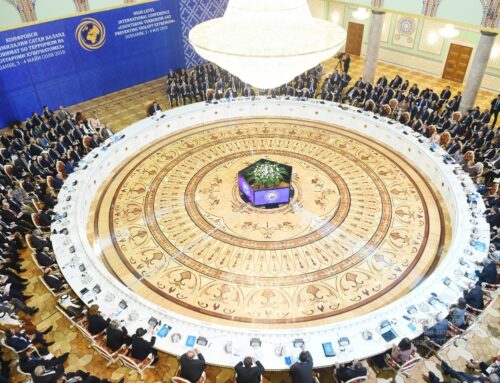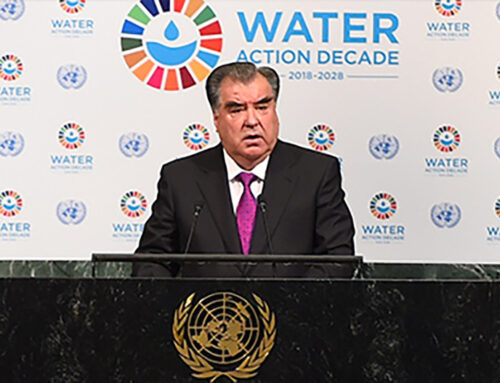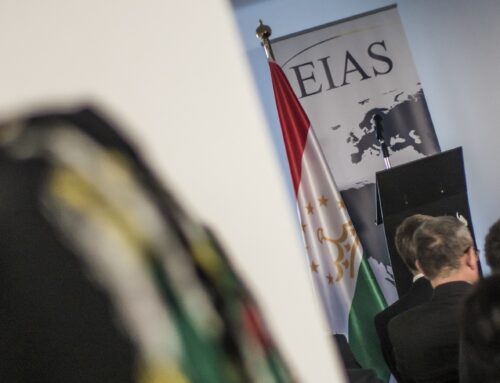PRESS RELEASE
STATEMENT
by
H.E. Mr. Sirodjidin ASLOV
Foreign Minister of the Republic of Tajikistan
at the High level Interactive Dialogue on “The International Decade for Action ‘Water for Life’, Progress Achieved and Lessons Learned for
Sustainable Development”
69th UNGA
March 30, 2015, UN Headquarters-Trusteeship Council, New York
 Distinguished Mr. Acting President,
Distinguished Mr. Acting President,
Distinguished Mr. Deputy Secretary-General,
Distinguished Mr. Prime Minister of the Commonwealth of Bahamas,
Ladies and Gentlemen,
First of all, on behalf of the Government of the Republic of Tajikistan, I would like to extend to the President of the General Assembly our appreciation for convening and organizing today’s High level interactive Dialogue on comprehensive review of the progress achieved in the implementation of the International Decade for Action ‘Water for Life’, 2005-2015.
Ten years ago on World Water Day, 2005, the International Decade for Action ‘Water for Life’, 2005-2015, a joint project of a global magnitude, was launched. The primary goal of the International Decade was to promote greater focus on implementation by 2015 the international water-related goals, among them, to halve the number of people without access to safe drinking water and sanitation. In addition, the International Decade placed a special emphasis on promoting the participation and involvement of women in water related issues, and the strengthening of international cooperation at all levels to promote the achievement of the set goals and objectives. In this way, a direct linkage was established between the Decade goals and the MDGs, the two fundamental projects of global dimension, both of which have now approached their final stage.
Today, when the time allocated for the implementation of these two global projects is up, I believe each of us asks himself/herself a question: ‘How close are we to the full implementation of the commitments we made?’ No simple answer to this question is available. On the one hand, we have made considerable progress in ensuring access to safe drinking water and sanitation, in increasing awareness of the water related challenges. On the other hand, the achieved progress remains unsustainable and uneven. Moreover, the increased awareness and knowledge of the existing water-related problems and challenges have not been translated into concrete practical and sustainable actions.
I would like to avail myself of this opportunity to note that in Tajikistan, on the territory of which 60 percent of all water resources of Central Asia originate, as of today, only 58.5 percent of the entire population have access to improved drinking water source and about 30 percent to improved sanitation facilities. This kind of problem is extremely urgent in the rural areas, where only 49 percent of the population has access to safe drinking water and about 10 percent – to improved sanitation. With the aim of promoting access to safe drinking water and developing the water infrastructure of the country, the Government of Tajikistan has been implementing “The Program on improvement of supply of the Tajikistan population with safe drinking water for 2007-2020”. As a result of the measures implemented in this field over five recent years about 1.2 million people were provided with improved water supply and over 600 thousand people got access to safe drinking water.
Today we have gathered not only to review the progress achieved in the implementation of the Decade but also the lessons learned relevant to the achievement of sustainable development agenda, which is under negotiations. Last week, the third round of intergovernmental negotiations had an in-depth discussion of the key elements of the post 2015 development agenda, in particular, sustainable development goals, targets and indicators. It is very inspirational that in the submitted sustainable development goals (SDGs) water is given due attention, and in addition to being included as a separate goal under # 6 it is also referred to in the other SDGs.
In my view, the main lesson learned during the International Decade is as follows: if we set ambitious targets, the means mobilized and allocated for their implementation should be equally ample. Experience shows that the targets can be achieved only if efficient mechanisms are in place and specific plans for their implementation, assessment and review are available. New plans and actions should be reinforced by adequate means of implementation, in particular, finance, human resources and capacity, investments and technologies. It is obvious that new conditions and realities demand a renewal and optimization of global partnership in the interests of sustainable development.
In addition, while developing new goals and targets we should take into consideration a number of factors that define future framework and opportunities for water cooperation:
First, climate change impacts water resources and considerably undermines our efforts. For instance, in recent decades the Tajikistan glaciers have degraded by 30 percent, and this tendency persists. The Fedchenko glacier, the largest continental glacier, has retreated by almost 1 km and lost about 2 cubic km in volume. Given the fact that about 60 percent of water resources of the Aral Sea originate on the territory of Tajikistan, the above situation raises serious concern and requires urgent measures on adaptation and achieving sustainability with regard to climate change.
Second, population growth and need in water resources set new and complex tasks. Tough competition for water resources under the ever increasing water shortage can have negative impact even within one country. We believe that introduction of integrated and nexus approaches to water resources management provide new opportunities for improvement of existing mechanisms of cross-sectoral and intergovernmental water cooperation.
Third, it is essential to take into account a gender component of water issues. Women should be actively involved in sustainable management and protection of water resources.
Fourth: the trans-boundary component of water cooperation is key to ensuring peace, stability and sustainable development. Efficient water cooperation can become a catalyst for development, while the lack of such collaboration can create risks and cause losses that have negative impact on economic and social situation in trans-boundary countries. In many regions of the world strengthening of the institutionalized potential of trans-boundary water cooperation and its adaptation to new realities promotes harmonious and coordinated development of all trans-boundary countries.
I would like to avail myself of this opportunity to site as an example the trans-boundary cooperation in Central Asia. It is known that the countries of the region share water resources of the two large rivers – the Amu Darya and the Syr-Darya, as well as those of a number of small trans-boundary waters. In Central Asian region, where a considerable part of water resources originate on the territory of one states, and the largest part of consumption of the available water resources falls on other states, efficient cooperation on management and use of water resources is key to sustainable development.
Establishment of the International Fund for Saving the Aral Sea and signing of a number of important agreements made it possible for the water infrastructures to function under the difficult conditions of transition to market economy. However, a considerable potential for cooperation in the region remains unused, in particular, in the field of use of water-and-energy resources. If used, it can bring considerable benefits to all the countries involved. In our view, the current legal and institutional framework in this sphere in the region needs to be improved and adjusted to the new conditions and realities. Alongside with this, it is necessary to reinforce such important mechanisms of water cooperation as equitable allocation of advantages, data exchange, joint assessment and monitoring, sharing of costs and benefits, financing of joint activities, etc. In addition, it is essential that Afghanistan, which shares the Amu-Darya basin with the countries of the region, get involved in the process of regional water cooperation.
In conclusion, I would like to note that today’s High level interactive dialogue is the first and very important event on comprehensive review of achievements and lessons learned during the implementation of the International Decade for Action ‘Water for Life’, 2005-2015. The next event envisaged by the UNGA resolution 69/215 is the High level Conference to review the implementation of the International Decade for Action ‘Water for Life’, 2005-2015, which will be held on June 9-10, 2015 in the city of Dushanbe. In this regard, I would like to use this opportunity to extend our appreciation to all delegations for the support of the above resolution and to invite representatives of governments, UN, international and regional organizations, civil society and business community to take part in the forthcoming High level Conference, at which we are going to continue and expand the dialogue that we have started today. The Government of Tajikistan is doing everything in its capacity to make the Conference a success so that its outcomes will contribute to further promotion of cooperation in the field of water resources.





